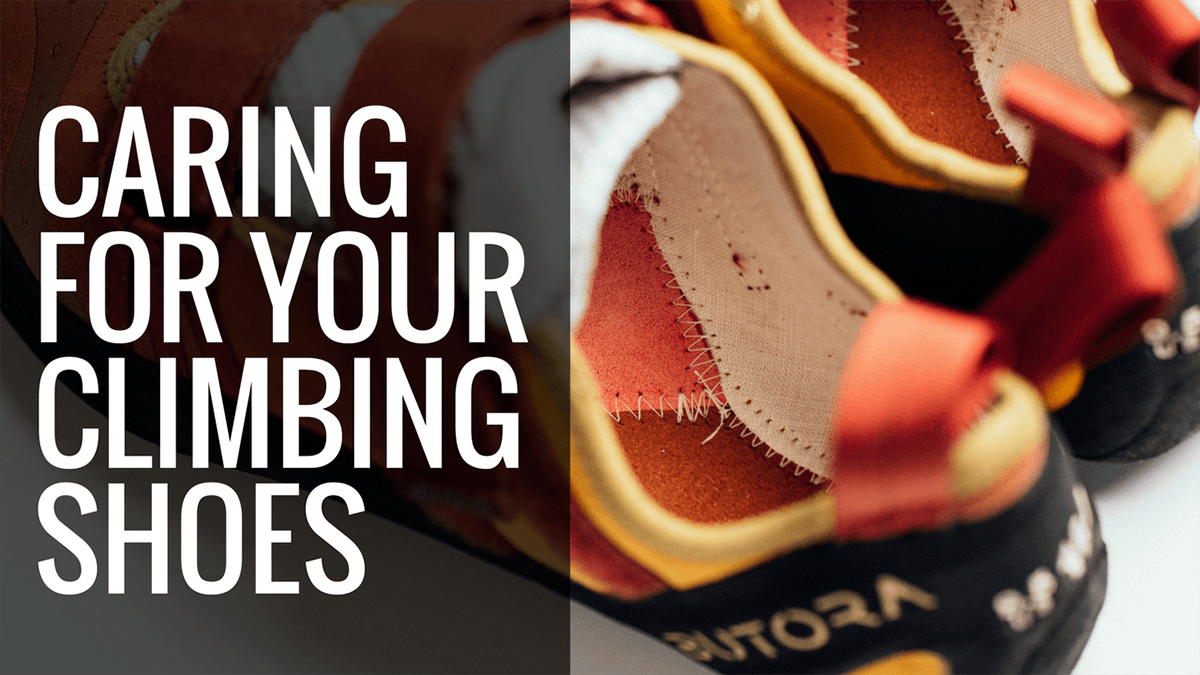How to Care for Your Climbing Shoes

Bottom line? Snug is good — painful is bad! You don’t want to end up with any number of nasty foot conditions (bunions, toe deformities, bleeding under the toenails, etc.) because of climbing shoes that are simply too tight! That said, it’s not as common to hear people talk about whether to wear socks or not, and how to avoid ending up with stinky climbing shoes!
In light of that, we thought it would be useful to discuss how to wear (and care) for your climbing shoes. After all, you spend a lot of money and put a lot of thought into getting the best shoes, so you naturally want them to last.
Socks or Skin
Aside from wearing socks with rented climbing shoes for hygienic reasons, most climbers skip socks when lacing up or strapping on their climbing shoes. Many recommend a light dusting of talcum powder or baking soda to absorb sweat, but you’ll need to be careful not to let it build up. The key is to go light and tap as much of it out as possible before wearing your shoes.
Caring for Climbing Shoes
It’s true that over time, most climbing shoes will develop a funky odor due to an accumulation of sweat, skin cells, dirt, etc. The question is, what can you do about it? Most climbers have developed their own “techniques” for dealing with smelly climbing shoes (powder, sprays, sachets), but is that enough? Here are some “dos and don’ts” for properly caring for your climbing shoes:
DO
- Take off your shoes between climbs to let both the shoes and your feet dry.
- Wipe out the insoles and linings with a damp cloth after a day of climbing and let your shoes air dry, being careful to avoid direct sunlight, which can damage your shoes.
- Spot clean the uppers with a little rubbing alcohol diluted with water. (You can use an old toothbrush for stubborn spots.) Be careful not to soak them, though, since soaking the leather will ultimately cause it to stiffen and break down.
- Wipe down the soles with a little rubbing alcohol at the end of the day to remove dust and grime and help restore stickiness.
- Remove your shoes from your pack as soon as you get home. Doing so will help prevent mildew and minimize odor.
- Use a deodorizing powder (lightly) or spray as needed to minimize odor. Anne-Worley Moelter, who owns a climbing and fitness facility, recommends sticking a couple of dryer sheets into shoes when not in use to keep them smelling fresh. She also recommends using an anti-fungal foot spray to kill germs.
- Make sure that the soles of your feet are clean before putting your climbing shoes on!
- Consider re-soling if your shoes’ soles wear out before the uppers do (this is pretty common). Resoling will be less expensive than buying new shoes. (Look online for repair shops that resole climbing shoes.
DON’T
- Wash leather climbing shoes in the washing machine!
- Walk around in your shoes when you’re not climbing. Many climbers carry along a small square of carpet or tarp to step on before getting on the rock. Dirt interferes with the effectiveness of your climbing shoes’ all-important sticky soles!
- Leave your shoes in your pack for an extended period. The more they’re exposed to air, the less likely they are to develop a rank odor.
- Leave your climbing shoes in a hot car. Extreme heat can deform rubber and delaminate rand (the rubber strip above the sole that wraps around the shoe). And consider the fact that heat is actually what cobblers use to remove soles from shoes!
Looking to replace your worn climbing shoes, or in the market for your very first pair? Butora has just what you’re looking for! We offer premium climbing shoes for every level of experience. Shop now!





